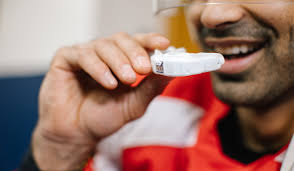Groundbreaking Studies Using Smart Mouthguard Data Illuminate Rugby Safety
3 min read
In a groundbreaking development for the world of rugby, independent studies utilizing data from smart mouthguards have provided unprecedented insights into the sport, reassuring players and parents about its benefits and safety. World Rugby Chairman Sir Bill Beaumont enthusiastically welcomed the results, marking a historic milestone in global sports.
Key Findings:
- Independent peer-reviewed studies reveal that a remarkable 86 percent of forces exerted on the head in community rugby are equivalent to or less than those experienced during general exercises like running and jumping.
- An extensive study conducted in collaboration with Elite Extension and Ulster University demonstrates that most contact events in men’s and women’s elite rugby do not subject players to significant forces.
- World Rugby is diligently implementing a six-point plan aimed at making rugby the most progressive sport worldwide in terms of player welfare.
- These findings, when combined with recent data from the ORCHID study on the health benefits of rugby, provide an all-encompassing perspective on the game.
The Otago Community Head Impact Detection study (ORCHID), a collaborative effort involving World Rugby, Prevent Biometrics, New Zealand Rugby, Otago Rugby, and the University of Otago, has unveiled the inaugural independent, peer-reviewed findings concerning community rugby. This exhaustive research spanned nearly two years and included over 17,000 separate head acceleration events across more than 300 players, ranging from senior rugby to U13s level.
Building on this work, the Elite Extension of the ORCHID study, carried out in partnership with Ulster University and Premiership Rugby, is set to release further insights into the women’s community game after undergoing peer review and publication.
Both studies harnessed the power of smart mouthguard technology provided by Prevent Biometrics to gauge the forces exerted on players’ heads during matches and training sessions. These mouthguards record g-forces experienced for less time than the blink of an eye, offering scientifically validated data both in research laboratories and on the field.
The ORCHID paper offers an enlightening perspective on men’s community rugby:
- 86 percent of measured forces are on par with or less than those encountered in everyday exercises such as running, jumping, or skipping.
- A staggering 94 percent of forces are lower than what has been previously measured on individuals riding rollercoasters.
- The majority of events resulting in the highest measured forces are attributed to poor tackling technique and breakdown situations.
The Elite Extension study corroborates these findings:
- Most contact events in elite rugby do not expose players to any significant head forces.
- Low, medium, and high force events, when they do occur, are most common in tackles and carries, followed by rucks.
- Both men’s and women’s forwards are more likely to experience force events than backs.
World Rugby has already acted upon preliminary ORCHID study findings by implementing trials for a lower tackle height in community rugby. The international federation has also expanded its online training resources for players and coaches, including the Tackle Ready and new Breakdown Ready programs.
At the elite level, World Rugby made history by announcing that smart mouthguards will be incorporated into the Head Injury Assessment (HIA) protocols starting in January 2024.
Dr. Melanie Bussey, Associate Professor in Biomechanics at the University of Otago, expressed her satisfaction with the study’s impact on player safety and performance analysis. She highlighted the potential of smart mouthguard technology to enhance rugby safety and performance analysis, stressing the importance of continued collaboration with stakeholders.
Dr. Gregory Tierney, Assistant Professor in Biomechanics at Ulster University, underlined the studies’ significance in monitoring head impact exposure and ensuring the game’s safety.
World Rugby Chairman Sir Bill Beaumont applauded these groundbreaking studies, emphasizing the organization’s commitment to evidence-led improvements in player welfare.
World Rugby Chief Medical Officer Dr. Eanna Falvey praised the ability of these studies to provide a comprehensive understanding of head impacts and accelerations, promising to leave no stone unturned in reducing significant head forces in the game.
New Zealand Rugby General Manager Community Rugby Steve Lancaster reaffirmed the sport’s commitment to safety, noting the positive impact of contributions from the New Zealand rugby community in initiatives like the reduced tackle height in community rugby.




